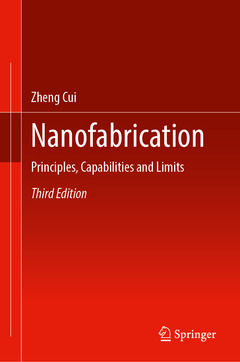Nanofabrication (3rd Ed., 3rd ed. 2024) Principles, Capabilities and Limits
Auteur : Cui Zheng

Nanofabrication: Principles, Capabilities, and Limits provides a practical guide to nanofabrication technologies and processes. It was first published in 2008 and is now in an updated third edition. The book introduces readers to the fundamentals and recent developments in nanofabrication techniques, with chapters covering optical lithography, electron beam lithography, and nanoimprinting lithography, as well as nanofabrication by focused ion beams, scanning tips, self-assembly, and nanoscale pattern transfer by etching and deposition. There is also a chapter describing various tricks that enable the fabrication of nanostructures that would otherwise be impossible using traditional methods. The unique feature of this book is that each technique introduced is not only about its capabilities but also its limits so that the readers are fully aware of the best options to choose from a toolbox of nanofabrication processes covered in the book.
Chapter 1. Introduction.- Chapter 2. Optical lithography.- Chapter 3. Electron beam lithography.- Chapter 4. Nanofabrication by focused ion beam.- Chapter 5. Tip-based nanofabrication.- Chapter 6. Nanoimprinting lithography.- Chapter 7. Nanoscale pattern transfer by etching.- Chapter 8. Nanoscale pattern transfer by deposition.- Chapter 9. Indirect nanofabrication.- Chapter 10. Nanofabrication by self-assembly.- Chapter 11. Applications of nanofabrication.- Chapter 9. Policing and investigating criminal activities by gangs using e-bikes, e-scooters and e-motorcycles in the United Kingdom.- Part IV-Police and Community Outreach and Collaboration. .- Chapter 10. Initiatives to improve Police – Community Collaboration and Trust.- Chapter 11. Understanding the Implementation of Community-oriented Policing in the New Zealand Police.
Zheng Cui received his Ph.D. in China in 1988 and went to the UK in 1989 as a Visiting Fellow at the Microelectronics Research Center, Cambridge University. In 1993, he became a Senior Scientist and later a Principal Scientist at Central Microstructure Facility, Rutherford Appleton Laboratory, UK. In 2009, he returned to China to join the Suzhou Institute of Nanotech and Nanobionics, Chinese Academy of Sciences, where he set up the Printable Electronics Research Center. In 2020, he retired from the Institute but has been carrying on as an advisor. He is now more involved in the industrial application of nanofabrication with key roles in a number of startup companies.
Date de parution : 08-2024
Ouvrage de 430 p.
15.5x23.5 cm



